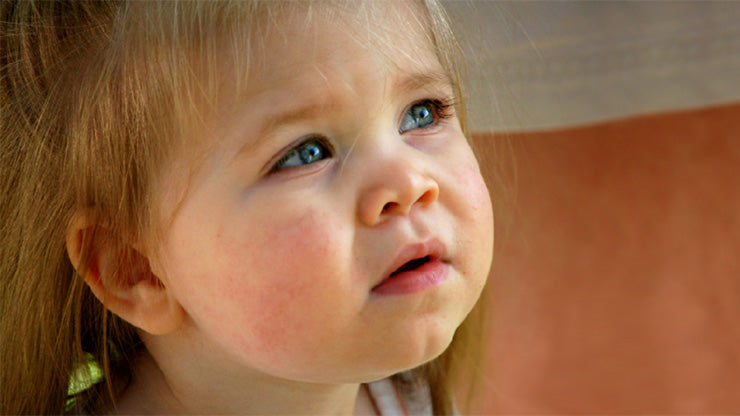Symptom Spotlight: Toddler Eczema

Eczema, also known as atopic dermatitis, is a condition that causes uncomfortable, itchy rashes for many toddlers. Read on to learn more about this common skin condition, its causes, and solutions.
What is Toddler Eczema?
Eczema is a general term for any ‘dermatitis’ or skin inflammation that affects up to 9.6 million children in the United States. It causes an itch-scratch cycle, meaning the inflammation leads to itching, and scratching the itch leads to the release of chemicals that leads to more inflammation.
What are the Symptoms of Toddler Eczema?
The symptoms associated with baby eczema may wax and wane, be mild, moderate, or severe, and may affect different parts of the body. Typically, children with eczema will have itchy, dry, and sensitive skin. In some, the skin may appear scaly, rough, red or darkened, and inflamed. If severe, it may ooze, crack, or even bleed.
Baby eczema may appear anywhere on the body. However, it most commonly affects the face, neck, wrists, ankles, and bends of the elbows and knees in children.
What are the Causes of Toddler Eczema?
The precise causes of baby eczema are unknown, and a variety of factors can trigger flare-ups. There may be a familial tendency towards eczema, and it may be related to conditions such as allergies, asthma, or food sensitivity.
In some children, contact irritants can aggravate the skin, such as soaps, shampoos, detergents, or even chlorine. For others, environmental allergens may be a trigger; these can include dust mites, pollen, mold, and dander (from house pets). Some parents notice that hot or cold temperatures can exacerbate their child’s eczema.
Foods that have been implicated in the development of eczema include cow milk products, wheat, eggs, soy, and even nuts and seeds.
Treating and Preventing Baby Eczema Symptoms
Eczema can be triggered by a long list of factors – and the ideal solution is finding and addressing the cause. Adopting some of the following healthy habits may reduce the frequency and intensity of your toddler eczema symptoms:
- Bathe children in warm water using mild, non-irritating soaps
- Pat skin dry rather than rubbing with a towel
- Moisturize skin daily, particularly after bathing
- Choose soft, cotton-based fabrics to prevent irritation
- Keep nails short to minimize the impact of scratching (some children may benefit from scratch mitts, especially overnight)
- In severe cases, protecting the skin with a barrier cream, such as a zinc oxide-based product
- In severe cases, a healthcare provider may prescribe a topical, low potency steroid cream to decrease inflammation
- Using a home air purifier, vacuuming more frequently or removing household carpets if environmental irritants are a suspected cause
Also, identifying and then removing a potential food trigger may help baby eczema symptoms. A useful starting point is to keep a 7-day diet diary to see a possible relationship between food intake and toddler eczema. If cow milk appears to be a trigger, consider swapping it out for naturally easy to digest Kabrita Goat Milk Formula*.
Kabrita Goat Milk Toddler Formula is designed to maintain the natural comfort of little ones during feeding transitions, such as weaning, supplementing, or changing formulas due to minor issues associated with cow milk sensitivity*.
*Not suitable for cow milk protein allergy
We encourage parents to consult their little one’s healthcare provider before making a feeding change.